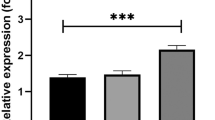Abstract
Osteoarthritis (OA) is the most common type of arthritis, in which T cell responses and cytokines may play critical roles in the development of the disease. TIM-3 may affect immune responses and is correlated with decreased expression of interferon gamma (INF-γ) in CD4+ T cells. In the current study, we investigated the association between polymorphisms in the TIM-3 gene and susceptibility to OA. Two polymorphisms in TIM-3, −574G/T and +4259T/G polymorphisms, were identified in OA cases and healthy donors by polymerase chain reaction–restriction fragment length polymorphism method. Data revealed that the prevalence of TIM-3 +4259T/G genotype was significantly elevated in OA patients than in the healthy donors after adjustment (Odds ratio [OR] = 2.67, 95 % confidence interval [CI] 1.32–5.11, P < 0.001). Similarly, the TIM-3 +4259G allele presented a positive association with the risk of OA after adjustment (OR = 2.58, 95 % CI 1.29–4.82, P = 0.003). The TIM-3 −574G/T polymorphism did not show any correlation with the disease. We further examined whether the two TIM-3 polymorphisms could affect INF-γ expression in CD4+ T cells. Data revealed that subjects carrying polymorphic +4259TG genotype had significantly higher mRNA and protein levels of INF-γ in CD4+ T cells compared to wild-type GG genotype (P < 0.001 and P < 0.01). These results indicated that TIM-3 polymorphism is associated with increased susceptibility to OA possibly by upregulating INF-γ expression in CD4+ T cells.


Similar content being viewed by others
References
Haseeb, A., and T.M. Haqqi. 2013. Immunopathogenesis of osteoarthritis. Clinical Immunology (Orlando, Fla.) 146: 185–196.
Han, S., S. Feng, G. Yuan, T. Dong, D. Gao, G. Liang, and X. Wei. 2014. Lysyl oxidase genetic variants and the prognosis of glioma. APMIS: Acta Pathologica, Microbiologica, et Immunologica Scandinavica 122: 200–205.
Chapman, K., and A.M. Valdes. 2012. Genetic factors in OA pathogenesis. Bone 51: 258–264.
Scanzello, C.R., A. Plaas, and M.K. Crow. 2008. Innate immune system activation in osteoarthritis: is osteoarthritis a chronic wound? Current Opinion in Rheumatology 20: 565–572.
Trembleau, S., M. Hoffmann, B. Meyer, V. Nell, H. Radner, W. Zauner, J. Hammer, G. Aichinger, G. Fischer, J. Smolen, and G. Steiner. 2010. Immunodominant T-cell epitopes of hnRNP-A2 associated with disease activity in patients with rheumatoid arthritis. European Journal of Immunology 40: 1795–1808.
Appel, H., R. Maier, P. Wu, R. Scheer, A. Hempfing, R. Kayser, A. Thiel, A. Radbruch, C. Loddenkemper, and J. Sieper. 2011. Analysis of IL-17(+) cells in facet joints of patients with spondyloarthritis suggests that the innate immune pathway might be of greater relevance than the Th17-mediated adaptive immune response. Arthritis Research & Therapy 13: R95.
Moradi, B., N. Rosshirt, E. Tripel, J. Kirsch, A. Barie, F. Zeifang, T. Gotterbarm, and S. Hagmann. 2015. Unicompartmental and bicompartmental knee osteoarthritis show different patterns of mononuclear cell infiltration and cytokine release in the affected joints. Clinical and Experimental Immunology 180: 143–54.
Shen, P.C., C.L. Wu, I.M. Jou, C.H. Lee, H.Y. Juan, P.J. Lee, S.H. Chen, and J.L. Hsieh. 2011. T helper cells promote disease progression of osteoarthritis by inducing macrophage inflammatory protein-1gamma. Osteoarthritis and Cartilage/OARS, Osteoarthritis Research Society 19: 728–736.
Lee, J., E.J. Park, J.W. Noh, J.W. Hwang, E.K. Bae, J.K. Ahn, E.M. Koh, and H.S. Cha. 2012. Underexpression of TIM-3 and blunted galectin-9-induced apoptosis of CD4+ T cells in rheumatoid arthritis. Inflammation 35: 633–637.
Anderson, A.C. 2012. Tim-3, a negative regulator of anti-tumor immunity. Current Opinion in Immunology 24: 213–216.
Lu, X.X., K.S. McCoy, J.L. Xu, W.K. Hu, and H.B. Chen. 2013. Small interfering RNA targeting T-cell Ig mucin-3 decreases allergic airway inflammation and hyperresponsiveness. Inflammation 36: 582–591.
Sakuishi, K., P. Jayaraman, S.M. Behar, A.C. Anderson, and V.K. Kuchroo. 2011. Emerging Tim-3 functions in antimicrobial and tumor immunity. Trends in Immunology 32: 345–349.
Zhu, C., A.C. Anderson, A. Schubart, H. Xiong, J. Imitola, S.J. Khoury, X.X. Zheng, T.B. Strom, and V.K. Kuchroo. 2005. The Tim-3 ligand galectin-9 negatively regulates T helper type 1 immunity. Nature Immunology 6: 1245–1252.
Cai, C., L. Wang, Z. Wu, M. Li, W. Chen, and Y. Sun. 2012. T-cell immunoglobulin- and mucin-domain-containing molecule 3 gene polymorphisms and renal cell carcinoma. DNA and Cell Biology 31: 1285–1289.
Song, H., S. Ma, Z. Cha, L. Chen, D. Tong, L. Ma, W. Song, and J. Bai. 2013. T-cell immunoglobulin- and mucin-domain-containing molecule 3 genetic variants and HIV+ non-Hodgkin lymphomas. Inflammation 36: 793–799.
Bai, J., X. Li, D. Tong, W. Shi, H. Song, and Q. Li. 2013. T-cell immunoglobulin- and mucin-domain-containing molecule 3 gene polymorphisms and prognosis of non-small-cell lung cancer. Tumour Biology: The Journal of the International Society for Oncodevelopmental Biology and Medicine 34: 805–809.
Tong, D., Y. Zhou, W. Chen, Y. Deng, L. Li, Z. Jia, and D. Qi. 2012. T cell immunoglobulin- and mucin-domain-containing molecule 3 gene polymorphisms and susceptibility to pancreatic cancer. Molecular Biology Reports 39: 9941–9946.
Wang, M., B. Ji, J. Wang, X. Cheng, Q. Zhou, J. Zhou, C. Cao, and Q. Guo. 2014. Tim-3 polymorphism downregulates gene expression and is involved in the susceptibility to ankylosing spondylitis. DNA and Cell Biology 33: 723–8.
Emrani, P.S., J.N. Katz, C.L. Kessler, W.M. Reichmann, E.A. Wright, T.E. McAlindon, and E. Losina. 2008. Joint space narrowing and Kellgren-Lawrence progression in knee osteoarthritis: an analytic literature synthesis. Osteoarthritis and Cartilage/OARS, Osteoarthritis Research Society 16: 873–82.
Acknowledgments
The work was supported by Shandong Provincial Natural Science Foundation, China (No. ZR2014HM049).
Conflict of Interests
None.
Author information
Authors and Affiliations
Corresponding authors
Additional information
Shufeng Li and Yanjun Ren contributed equally to this work.
Rights and permissions
About this article
Cite this article
Li, S., Ren, Y., Peng, D. et al. TIM-3 Genetic Variations Affect Susceptibility to Osteoarthritis by Interfering with Interferon Gamma in CD4+ T Cells. Inflammation 38, 1857–1863 (2015). https://doi.org/10.1007/s10753-015-0164-7
Published:
Issue Date:
DOI: https://doi.org/10.1007/s10753-015-0164-7



